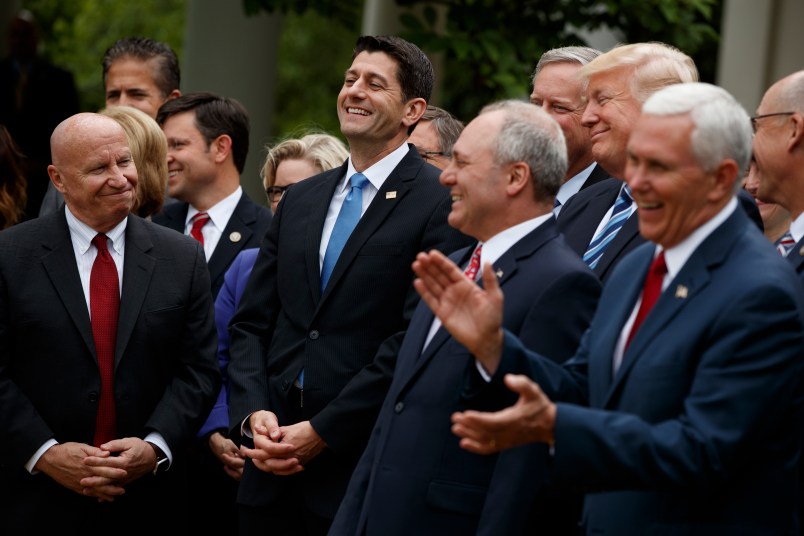Late update, 8:09 p.m. ET: The respected bipartisan Tax Policy Center took the unusual step late Monday of retracting its initial analysis of the House Republican tax bill after finding an error in its modeling.
“This error involved the additional child tax credit component of the proposed legislation,” TPC said on its blog. “TPC staff are in the process of revising the analysis and will release a corrected version as soon as possible.”
Original story, headlined “Study: Under GOP Tax Bill, Millions Pay More While Top 1% Gets Major Breaks”
An analysis of House Republicans’ tax bill released Monday by the non-partisan Tax Policy Center found a wide disparity between the winners and losers under the plan—with the wealthiest 1 percent of Americans netting nearly 50 percent of all the benefits and nearly 30 percent of Americans seeing an increase in their tax bill after 10 years.
Thanks to the loss of several popular tax deductions, including state and local taxes, medical expenses, student loan interest and others, the report estimates that 12 percent of taxpayers would pay higher taxes starting in 2018 and at least 28 percent of taxpayers would pay more by 2027.
Should the GOP tax plan pass Congress and go into effect in 2018—a big if at this juncture—nearly everyone in every income group would see a reduction in their taxes next year. But that benefit is not spread evenly.
The Tax Policy Center estimates that taxpayers making less than $48,000 a year would get a “modest” tax cut of between 0.3 and 0.5 percent, while those in the top 1 percent would see a much larger cut of 2.5 percent—saving about $37,000 a year on average.
By 2027, after many of the middle class tax cuts in the GOP plan expire, the difference would be even more stark. The report found that people earning less than $55,000 a year would see an average increase in their taxes, of nearly $2,000, while those in the top 1 percent would get an average tax break of nearly $53,000. For the richest of the rich, the top 0.1 percent of Americans, the windfall is even greater: an average of nearly $300,000 a year.
Read the full report below:







None of this “simplifies” the tax code, either, and you couldn’t fit the end result on a postcard unless it was the size of Wyoming.
There’s a lot not to like about this, but I gotta say, getting rid of the student loan interest deduction and the tax exempt status for tuition waivers is pretty low (and tone deaf). Coming out of grad school, getting that extra cash back from all the loan payments I made over the course of the year was extremely helpful – and some of those loans were private, too, so they weren’t exactly 3% interest. Just unreal. And to pay for a tax cut to some of the jerks who’re responsible for high interest on student loans to begin with.
Socialism for the wealthy - siphon more money from the masses for the exclusive possession of the wealthy. In the process further degrade public services, the safetynet, and our infrastructure. Brownback’s Kansification - for all of America.
For those who haven’t read this - pass this article along - it is where we are heading:
http://prospect.org/article/kansas-sam-brownback-and-trickle-down-implosion-0
Wait, so you’re telling me the GOP tax plan gives the biggest cuts to the very top of the wealth distribution?
I’m one of those people who has massive medical deductions. If they go away, I’m out about $30,000 a year.